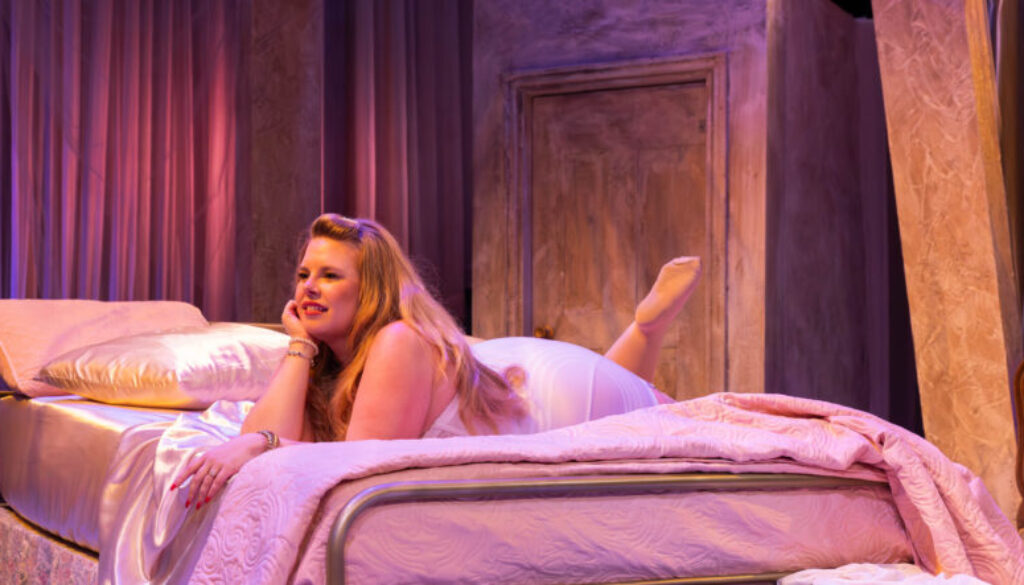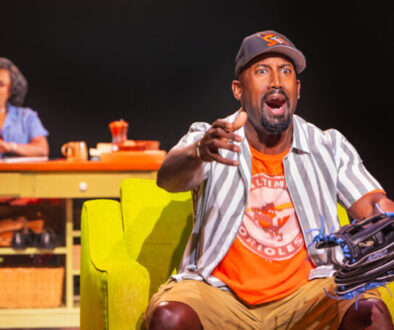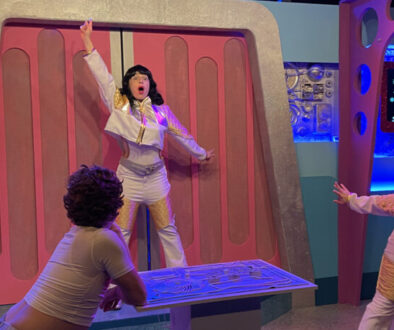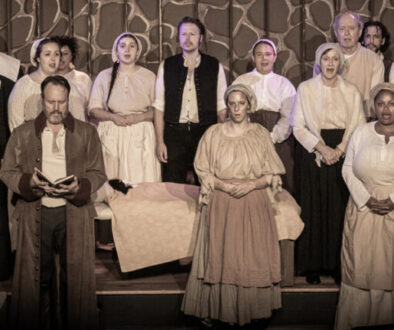By ALAN SMASON, WYES-TV Theatre Critic (“Steppin’ Out“)
It’s taken ten years for the Tennessee Williams Theatre Company of New Orleans (TWTC) to unveil its first production of Tennessee Williams’ Cat on a Hot Tin Roof. Along with A Streetcar Named Desire and The Glass Menagerie, it is considered the third jewel in the crown of the playwright’s most famous works.

Known for presenting many of Williams’ lesser-known works, TWTC presented Williams’ memory play, The Glass Menagerie, in its fifth season and had a successful staging of A Streetcar Named Desire just last year. So, it has been a full 10 years since their founding that they finally turned to this famous story of sexual repression, desire, avarice and mendacity.
Rest assured, though, the wait is well worth it.
Directed by co-artistic director Augustin J Correro, Cat on a Hot Tin Roof possesses many outstanding qualities that make it quite satisfying, not the least is the stellar casting of Rebecca Elizabeth Hollingsworth in the role of Maggie. Hollingsworth, who has been on the local scene for several years, proved her worth in last year’s revival of The Kingdom of Earth, a show that was first produced by TWTC in its inaugural theatre season in New Orleans scene a decade ago.

Hollingsworth more than fills the demanding role of a wanton and lusty Maggie seeking the solace of her husband Brick’s company and companionship. Despite his disinterest, she continues to throw herself at him time after time in Act One. Brick, played in a fairly understated performance by Brandon Kotfila, is full of disgust and liquor as he navigates life with little or no self-respect, blaming himself for the death of his best friend Skipper. Maggie deflects his revulsion to her more-than-ample charms, while atill attempting to be a cheerleader and defender of him to her father-in-law, Big Daddy (Randy Cheramie).
Williams is credited at having written especially well with a woman’s voice and in Maggie he has a strong-willed and determined leading lady. As Maggie, Hollingworth proves she can be as gracious as any genteel Southern belle, but can also go toe to toe in battle over what she truly wants. And Brick is what she wants.
Kotfila holds true to the character of Brick, who wards off the advances of Hollingsworth’s Maggie, while waiting for the “click” he feels (“It’s just a mechanical thing”) to make him restful and forgetful.
Cheramie is a veteran in the role of Big Daddy, having played him four times previously. Married for 40 years, Big Daddy has nothing but utter disdain for his own wife Big Mama, played delightfully by Margeaux Fanning, and most of the members of his family. Having been a taker most of his life, Big Daddy begins to concentrate on his legacy and what his life has accounted to thus far. In Brick, he sees the best of himself, a former athlete and a latter-day sportscaster with whom he can be proud. But despite Brick being capable, he wants nothing of what Big Daddy can offer, preferring to wallow in a sea of alcohol and the disarray of a failed life.
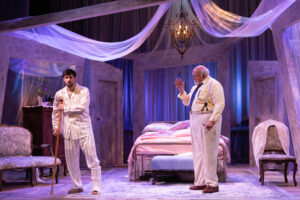
Grieving over the recent death of his best friend Skipper, Brick continues to descend into the depths of dypsomania. We sense there is more to it than his professed hatred of Maggie and she knows innately that Brick is grieving more than any man should for a simple friend. In an ill-advised attempt to prove that Skipper and Brick were not an actual couple, we learn she seduced Skipper while Brick was away. This resulted in the downward spiral that eventually led to Skipper’s suicide and Brick’s descent into depression. Maggie is clueless that it was her own actions that triggered the tragedy unfolding in her own life, but she is a woman who embraces life and will not let disgust or hate interfere in her life.
In Act Two, Big Daddy decides he will get to the bottom of what is troubling Brick. Big Daddy’s older son Gooper (Andrew Niemann) lays in wait with papers to take over the 28,000 acre plantation, one of the best and biggest in the Mississippi Delta.
Gooper’s wife Mae (Monica Harris) has major designs on the property and several of her five “no neck monsters,” are running through the house in celebration of Big Daddy’s 65th birthday. Always clutching a newborn, Harris is a bit over the top in her portrayal as the manipulative and perpetually pregnant mother. Williams, of course, placed her character in direct contrast to the childless and sex-starved Maggie, which heightens her dismay with Mae (pun intended).
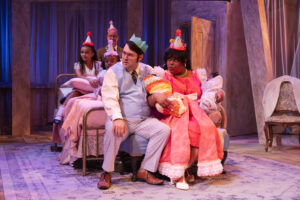
Seeing Big Daddy in a state of depression, Gooper and Mae conspire with Big Daddy’s doctor and the Ochsner Clinic staff to placate him and maybe bring him out of his doldrums. Gooper, an attorney, plans to have Big Mama sign papers that would eventually give them control of the property. But buoyed by their contrived news of the clinic’s diagnosis of a “spastic colon,” which is specifically not cancer, Big Daddy unexpectedly emerges from his cycle of despondency and literally begins to put his house in order. The first order of business is to find out what’s troubling Brick. Big Daddy goes from the suffering to the insufferable.
Big Daddy is emboldened to joust with Brick. Now that he no longer believes he is dying, he bullies his son and announces he will take the lead in running his own failed marriage. Married for 40 years, he has nothing but utter disgust for his own wife and doesn’t care much for his oldest son, his daughter-in-law nor his grandkids.
In Cat on a Hot Tin Roof, there is an emphasis on confrontation. When change does occur, it is largely unwelcome. This production restores the original ending Williams always preferred, prior to Elia Kazan’s rewrite of the play with a more hopeful ending. That was done to make the work more acceptable in Hollywood circles when it was adapted into a major studio release for Elizabeth Taylor and Paul Newman. Many of the more veiled references to Brick’s suggested homosexuality and language that is not politically correct are back in with this production.
This is the original ending, where Big Daddy is not seen at play’s end. It was most recently seen on stage in another local production of the same work in 2023.
Executive producer and co-artistic director Nick Shackeford’s sound designs lend added dimension to the staging and Nathan Arthur’s scenic design is also outstanding, given the small Marquette Theater stage on which the action takes place.
Diane K. Baas does a wonderful job as the lighting director for this production, while costumes by Kelsey Brehm are also quite superb. Helen Jaksch served as the dramaturg.
Cat on a Hot Tin Roof (2 hours and 45 minutes with an intermission), continues at the Marquette Theater with shows Thursday through Saturday at 7:30 p.m. and Sunday matinees at 3:00 p.m., now through August . Tickets are available here.

